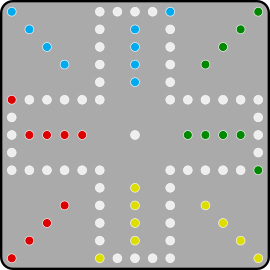
Chinese checkers (US) or Chinese chequers (UK), known as Sternhalma in German, is a strategy board game of German origin that can be played by two, three, four, or six people, playing individually or with partners. The game is a modern and simplified variation of the game Halma.

Ludo is a strategy-based board game for two to four players, in which the players race their four tokens from start to finish according to the rolls of a single die. Like other cross and circle games, Ludo originated from the Indian game Pachisi. The game and its variations are popular in many countries and under various names.

Trouble is a board game in which players compete to be the first to send four pieces all the way around a board. It is based on a traditional game called "Frustration" played on a wooden board with indentations for marble playing pieces and rules similar to Parcheesi. Pieces are moved according to the roll of a die using a contained device called a "Pop-O-Matic".

Sorry! is a board game that is based, like the older game Ludo, on the ancient Indian cross and circle game Pachisi. Players move their three or four pieces around the board, attempting to get all of their pieces "home" before any other player. Originally manufactured by W.H. Storey & Co in England and now by Hasbro, Sorry! is marketed for two to four players, ages 6 and up. The game title comes from the many ways in which a player can negate the progress of another, while issuing an apologetic "Sorry!"
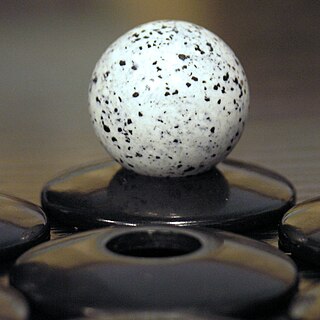
ZÈRTZ is the third game in the GIPF Project of seven abstract strategy games. The game features a shrinking board and an object that promotes sacrifice combinations. It is impartial: since neither player owns on-board pieces, maintaining the initiative is of fundamental importance.
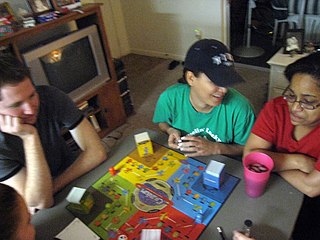
Cranium is a party game created by Whit Alexander and Richard Tait in 1998. Initially, Cranium was sold through Amazon.com and the Starbucks coffee chain, then-novel methods of distribution. After selling 44 million copies of Cranium and its sister titles, the game's manufacturer Cranium, Inc. was bought by Hasbro, Inc. for $77.5 million in 2008. Billed as "The Game for Your Whole Brain", Cranium includes a wide variety of activities, unlike many other party games. Murray Brand Commuications and brand strategist, Sonali Shah handled packaging and branding for the game, and the artwork is by cartoonist Gary Baseman.

A marble is a small spherical object often made from glass, clay, steel, plastic, or agate. They vary in size, and most commonly are about 13 mm in diameter. These toys can be used for a variety of games called marbles, as well being placed in marble runs or races, or created as a form of art. They are often collected, both for nostalgia and for their aesthetic colors.

Hungry Hungry Hippos is a tabletop game made for 2–4 players, produced by Hasbro, under the brand of its subsidiary, Milton Bradley. The idea for the game was published in 1967 by toy inventor Fred Kroll and it was introduced in 1978. The objective is for each player to collect as many marbles as possible with their toy hippopotamus model. The game was, at one point, marketed under the "Elefun and Friends" banner, along with Elefun, Mouse Trap and Gator Golf.
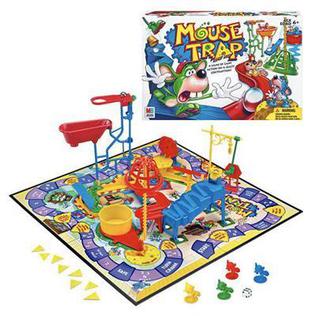
Mouse Trap is a board game first published by Ideal in 1963 for two to four players. It is one of the first mass-produced three-dimensional board games. Players at first cooperate to build a working mouse trap in the style of a Rube Goldberg machine. Then, players turn against each other to trap opponents' mouse-shaped game pieces.
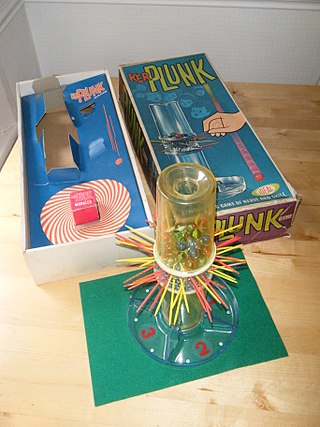
KerPlunk is a children's game invented by Eddy Goldfarb with Rene Soriano and first marketed by the Ideal Toy Company in 1967. The game equipment consists of a transparent plastic tube, plastic rods called straws and several dozen marbles. The base contains four separate numbered trays; the straws are passed through holes in the middle of the tube to form a lattice. The marbles are then placed in the top of the tube and held in place by the lattice. The onomatopoeic name of the game derives from the sound of the marbles tumbling to the base of the tube during play.

Perfection is a game originally produced by the Pennsylvania company Reed Toys and then by the Milton Bradley company. The object is to put all the pieces into matching holes on the board before the time limit runs out. When time runs out, the board springs up, causing many, if not all, of the pieces to fly out. In the most common version, there are 25 pieces to be placed into a 5×5 grid within 60 seconds.

Finance, or The Fascinating Game of Finance or Finance and Fortune, is a board game originally released in 1932. The game is based on The Landlord's Game in the movement of pieces around the board, the use of cards, properties that can be purchased, and houses that can be erected on them. The game also has railroads; however, these may not be purchased. The game is a predecessor to Monopoly.

Tock is a board game, similar to Ludo, Aggravation or Sorry!, in which players race their four tokens around the game board from start to finish—the objective being to be the first to take all of one's tokens "home". Like Sorry!, it is played with playing cards rather than dice.

Aeroplane chess is a Chinese cross-and-circle board game similar to the Western game of Ludo and the Indian game of Pachisi. Developed in the 20th century, aeroplane chess features airplanes as pieces instead of the more abstract pawns and beehive-shaped pieces found in the games from which it is derived. Aeroplane chess has spread around the world, especially in Africa.

Wahoo is a cross and circle board game similar to Parchisi that involves moving a set number of marbles around the board, trying to get them into the safety zone. The game is alleged to have originated in the Appalachian hills, but it is nearly identical to Mensch Ärgere Dich Nicht, a German board game originating in 1907. Most boards are used by two to four players. Wahoo has been a popular game for decades. Even today, custom-made boards proliferate on eBay and game manufacturer Parker Brothers has sold their own version of the game, under the title Aggravation, for decades.
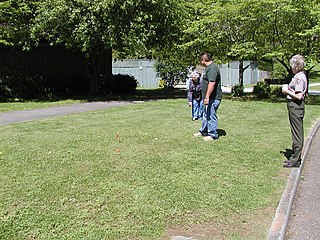
Cherokee marbles, or five hole is a traditional game among the Cherokee people of the United States, in which players roll small stone balls between five shallow pits dug into a playing field. Today, the game is commonly played with billiard balls. The game may be played in individual or team play, and in this century, has been introduced into the curricula of students attending schools in the Cherokee Nation. There is also a national tournament held annually during the Cherokee National Holiday.

Four-field kono is an abstract strategy game from Korea. Each player attempts to capture the other player's pieces by jumping over their own piece and landing on the other player's piece. The game is not related or similar to another Korean game called five-field kono.
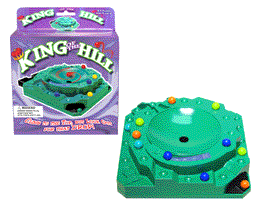
King of the Hill is a race game, where players try to be the first to get their marbles from the start to the top of the mountain. It was originally published by Schaper Toys in 1960. It was re-released in 2006 with slightly different rules by Winning Moves Games USA, but is no longer in production.

Stay Alive is a strategy game, where 2-4 players try to keep their marbles from falling through holes in the game board while trying to make their opponents' marbles fall through. It was originally published by Milton Bradley in 1971 and marketed in television and print advertising as "the ultimate survival game". Stay Alive was republished with a smaller board by Winning Moves Games USA in 2005.

Avalanche, also marketed as Lawine in the Netherlands, Avalancha in Spain, and Astroslide or Skill in Germany, is an abstract, mechanical strategy game published by Parker Brothers in 1966 that features colored marbles that roll down an inclined board.





